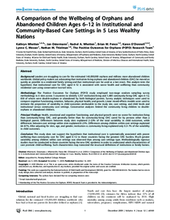Global policy makers are advocating that institution-living orphans and abandoned children (OAC) be moved as quickly as possible to a residential family setting and that institutional care be used as a last resort. This analysis tests the hypothesis that institutional care for OAC aged 6–12 is associated with worse health and wellbeing than community residential care using conservative two-tail tests. The five countries (Cambodia, Ethiopia, India, Kenya, and Tanzania) selected were culturally, historically, ethnically, religiously, politically, and geographically diverse from each other. Political boundaries were used to define six study areas, with two study areas--Hyderabad and Nagaland--in India. The Positive Outcomes for Orphans (POFO) study employed two-stage random sampling survey methodology across the 6 sites to identify 1,357 institution-living and 1,480 community-living OAC ages 6–12, 658 of whom were double-orphans or abandoned by both biological parents. Survey analytic techniques were used to compare cognitive functioning, emotion, behavior, physical health, and growth. Linear mixed-effects models were used to estimate the proportion of variability in child outcomes attributable to the study site, care setting, and child levels and institutional versus community care settings. Conservative analyses limited the community living children to double-orphans or abandoned children.
The study found that health, emotional and cognitive functioning, and physical growth were no worse for institution-living than community-living OAC, and generally better than community-living OAC cared for by persons other than a biological parent. Differences between study sites explained 2–23% of the total variability in child outcomes, while differences between care settings within sites explained 8–21%. Differences among children within care settings explained 64–87%. After adjusting for sites, age, and gender, institution vs. community-living explained only 0.3–7% of the variability in child outcomes. This study does not support the hypothesis that institutional care is systematically associated with poorer wellbeing than community care for OAC aged 6–12 in those countries facing the greatest OAC burden. Much greater variability among children within care settings was observed than among care settings type. Methodologically rigorous studies must be conducted in those countries facing the new OAC epidemic in order to understand which characteristics of care promote child wellbeing.

